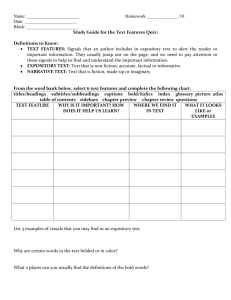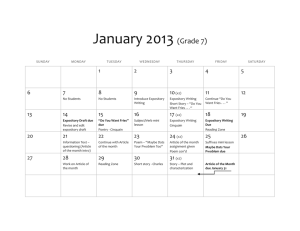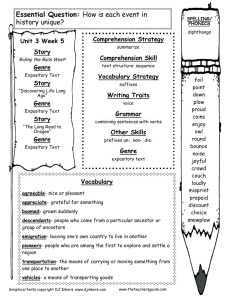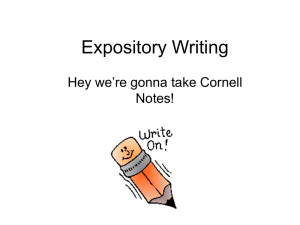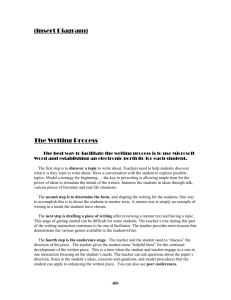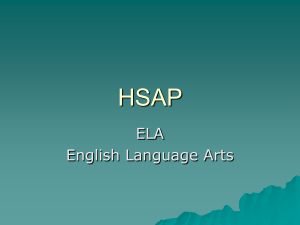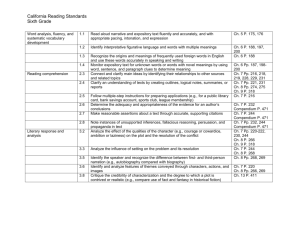Expository Writing
advertisement
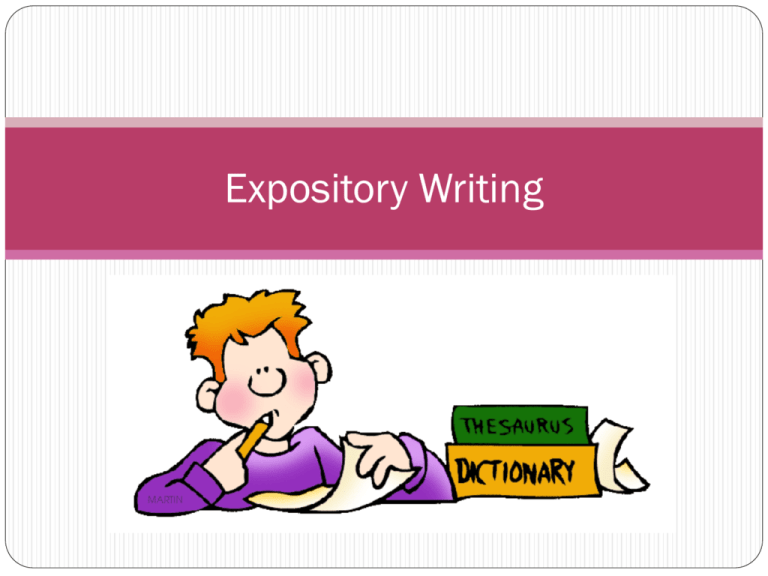
Expository Writing What is expository writing? Writing intended to inform the reader Writing that explains, describes, gives information, informs or defines Writing that answers the questions: Who? What? Where? When? Why? How? Good expository writing needs to be clear and precise. When to use expository writing When you want to: Tell what happened when… Write a report on… Explain how to… Describe how to… Forms of expository writing Non fiction books Textbooks Manuals Pamphlets Magazines Journals Letters Definitions Research papers Expository Writing Activity 1 Handshake People use hand-to-hand touch between individuals to convey a wide range of affective communication. Your teacher will share one of these with you (like a handshake). You will each leave the room, and receive a secret handshake. When you return to the classroom, your job is to write a paragraph detailing the exchange in such a way that someone else could read your description and duplicate the action. In your paragraph, you cannot simply say “shook my hand hard, with power”, or “gave me a fist pump”, but instead you must describe the exchange in detail, including such things as direction, strength, position, etc. You will get the opportunity to try out your description with a peer to see how clear your directions are and if the “shake” can be replicated. Characteristics of good expository writing Focus on a main topic Use logical, supporting facts Give sufficient details, explanations and examples Make sure your ideas are clear and precise Use smooth transitions Use words that clearly show what you are talking about Do not assume your reader has prior knowledge of the topic Present ideas in a logical order Use strong organization Expository Organizational Patterns Pattern Description Circumlocution Depicts a pattern in which the speaker discusses a topic, then diverts to discuss a related but different topic. (diverted thinking) Cue words Friend, [1] I can still remember when we where freshmen and we planned to take a trip to Mexico. As soon as either one of us learned to drive we were gonna take off south of the border. I've been looking forward to it for three years and that's why I'm so disappointed that we can't go. It's just that I know that we're gonna have to be shelling out the big bucks for our senior year. I mean, with the prom, grad-night, pictures, etc. [2] Speaking of learning to drive, when are we going to get our licenses? I thought I was bad because I took safety education and drivers training in November 2008. But you're worse. If I'm not mistaken, you took them both in June, „07. So I'm jammin' compared to you. I guess we're both just too lazy to go down to the DMV. [3] Speaking of lazy, I don't want to work mornings. I hate having to get up early just to feed cinnamon rolls to grouchy, half-awake, old people. I'd rather keep working afternoons and evenings when all the gorgeous guys drop in on their lunch breaks... Expository Organizational Patterns Pattern Description Cue words Narrative interspersion A pattern or a sub-pattern imbedded in other patterns in which the speaker or writer intersperses a narrative within the expository text for specific purposes, including to clarify, or elaborate on a point or to link the subject matter to a personal experience. Dear friend, [1] Hey girl... what's up?... I guess I want to talk to you about 'Self Destruction'. Personally, I don't know anyone who uses drugs but I do know people who are hard headed and ignorant. And we both know girls who are always in trouble... Too many girls out there are getting pregnant and using drugs. At the same time, they don't care. And all this stuff about 'colors', you know Red and Blue Crips and Bloods... That's all B.S. Just another reason to shoot a brother. It's like Kool Moe Dee said, "I never ever ran from the Ku Klux Klan, and I shouldn't have to run from a Black man...cuz that's 'Self Destruction.' It's a serious trip how most violence to Blacks is done by Blacks. [2] Then there's discrimination between Blacks because of lighter and darker shades. Like when people call me 'white girl' before, of course, I got this tan. I'm sort of glad that I'm not that light anymore. But, I'm still teased by the way I talk because it's too proper. But that's just the way I talk. One night I was talking [3] on the phone to Jimmy, my boyfriend, when some of his friends started to talking to me on the phone. Whenever they'd talk to me, they'd assume I was white. The first time they did that, it really made me mad. But I don't get mad anymore. I'm used to it. It gets me mad when they think I think I'm better than them. But I don't think that. [4] And another thing I hate is drugs. That's stupid too. Drugs ruin people's lives and it's even worse that people are willing to die for them.... Expository Organizational Patterns Pattern Description Recursion When the speaker discusses a topic, then restates it using different words or symbolism. It is used to drive home a point and to give special emphasis to the text. [1] Yes, we're on the move now, [2] and no wave of racism can stop us; [3] and the burning of churches will not deter us. [4] and the bombing of our homes will not dissuade us [5] and the beating and the killing of our clergymen and young people will not divert us. [6] The wanton release of their known murderers will not discourage us. [7] We're on the move now! Cue words Expository Organizational Patterns Pattern Description Cue words Description The author describes a topic by listing characteristics, features, and examples for example, characteristics are The Olympic symbol consists of five interlocking rings. The rings represent the five continents - Africa, Asia, Europe, North America and South America - from which athletes come to compete in the games. The rings are colored black blue, green, red, and yellow. At least one of these colors is found in the flag of every country sending athletes to compete in the Olympic games. Expository Organizational Patterns Pattern Description Cue words Sequence The author lists items or events in numerical or chronological order. first, second, third; next; then; finally The Olympic games began as athletic festivals to honor the Greek gods. The most important festival was held in the valley of Olympia to honor Zeus, the king of the gods. It was this festival that became the Olympic games in 776 B.C. These games were ended in A.D. 394 by the Roman Emperor who ruled Greece. No Olympic games were held for more than 1,500 years. Then the modern Olympics began in 1896. Almost 300 male athletes competed in the first modern Olympics In the games held in 1900, female athletes were allowed to compete. The games have continued every four years since 1896 except during World War II, and they will most likely continue for many years to come. Expository Organizational Patterns Pattern Description Cue words Comparison The author explains how two or more things are alike and/or how they are different. different; in contrast; alike; same as; on the other hand The modern Olympics is very unlike the ancient Olympic games. Individual events are different. While there were no swimming races in the ancient games, for example, there were chariot races. There were no female contestants and all athletes competed in the nude. Of course, the ancient and modern Olympics are also alike in many ways. Some events, such as the javelin and discus throws, are the same. Some people say that cheating, professionalism, and nationalism in the modern games are a disgrace to the Olympic tradition. But according to the ancient Greek writers, there were many cases of cheating, nationalism, and professionalism in their Olympics too. Expository Organizational Patterns Pattern Description Cue words Cause and effect The author lists one or more causes and the resulting effect or effects. reasons why; if...then; as a result; therefore; because There are several reasons why so many people attend the Olympic games or watch them on television. One reason is tradition. The name Olympics and the torch and flame remind people of the ancient games. People can escape the ordinariness of daily life by attending or watching the Olympics. They like to identify with someone else's individual sacrifice and accomplishment. National pride is another reason, and an athlete's or a team's hard earned victory becomes a nation's victory. There are national medal counts and people keep track of how many medals their country's athletes have won. Expository Organizational Patterns Pattern Description Cue words Problem and Solution The author states a problem and lists one or more solutions for the problem. A variation of this pattern is the question- and-answer format in which the author poses a question and then answers it. problem is; dilemma is; puzzle is solved; question... answer One problem with the modern Olympics is that it has become very big and expensive to operate. The city or country that hosts the games often loses a lot of money. A stadium, pools, and playing fields must be built for the athletic events and housing is needed for the athletes who come from around the world. And all of these facilities are used for only two weeks! In 1984, Los Angeles solved these problems by charging a fee for companies who wanted to be official sponsors of the games. Companies like McDonald's paid a lot of money to be part of the Olympics. Many buildings that were already built in the Los Angeles area were also used. The Coliseum where the 1932 games were held was used again and many colleges and universities in the area became playing and living sites. Why teach exposition? Let's think about the type of writing that most of us encounter in our daily lives. When you pick up and read a non-fiction book, magazine, or newspaper article the author uses expository writing to inform you, the reader, about the topic. At school, students are required to submit school exams and research papers as a means for their teachers to grade their progress. Finally, at work, people are required to produce business reports and memorandums to inform their superiors and co-workers about the occurrences that take place at other levels of the company. Why teach exposition? In addition, oral exposition is primarily observed in oral academic presentations, business talks, and speeches that are delivered to a group of people. As each of these different cases illustrate, expository writing and speech surround us in our everyday lives. These lessons will help move students closer to mastering the hows, whens, and wheres to select different oral and written expository styles for a variety of real world contexts. Précis Writing What is a precis? Also called a summary or an abstract Takes the main points of a piece of writing and tells them in a smaller portion Usually 1/3 to ¼ the length of the original piece Is written IN YOUR OWN WORDS – avoid pulling out parts of the original – try to make it your own Does not include your opinion, but stays true to the voice of its author Usually maintains the order of the original Eliminates extra details, facts and examples, and only includes the vital information Précis Writing How do you write a précis? Start by reading the original piece of writing Re-read the piece of writing, this time underlining or pulling out the main points of each paragraph, in the original words, like a quotation Next, rewrite the main points in your own words, in the form of a paragraph Finally, include transitions to make the writing smooth, and narrow your writing to the exact number of words requested Précis Writing – Practice Read an article. Take the main point of each major paragraph (write out the exact wording) – what would be the topic sentence of the paragraph (like the thesis of each paragraph)? Then, take each of the main points and put them into your own words. When you have the main points in your own words, put them together into a paragraph. In this step it will be necessary to link the ideas by using transitional words and phrases. Give it a try!! Précis Writing – Practice (sample) Exact wording from original Put into your own words Paragraph 1: “less than two weeks before the [Berlin] wall fell, a Summerside man felt so threatened by his estranged wife that he shot her dead.” Even though there have been major events to end oppression, like the falling of the Berlin wall, oppressive acts still persist, like the Summerside man who shot his wife. Expository Writing Activity 2 How clear are the instructions? Have you ever tried to follow a set of directions or instructions, but were completely stumped? How did this make you feel? What makes for good directions/instructions? Expository Writing Activity 2 How clear are the instructions? We are going to attempt to follow instructions on how to create an origami boat. Origami Boat Instructions When you have gone through the set of instructions, respond to the following questions? How clear were the instructions? Did your boat turn out correctly? What did you find challenging about the activity/instructions? What worked well with the instructions? What tips would you give the writer of these instructions to make them more clearly understood? Expository Writing Activity 3 Directions on a Map Some might say that Colonel Gray has a complex layout. When you first started here, you probably had a bit of a challenge finding your classrooms. This mapping activity plays on those challenges. You will be given two positions in the school (ex. cafeteria to gym). With those positions, you must write out detailed directions so that someone new to the school could then get from point A to point B by following them. You will have 7 minutes to walk the route, noting any important details that you could use in your directional paragraph. Expository Writing Activity 3 Directions on a Map You will then come back to class, and write your paragraph. Your directions must not give away the final destination. You must give the starting point, then give proper directions so your classmate can make it to the proper destination by retracing your steps on a map of the school. Make use of transitional words and phrases in your piece to make for a clearly organized and fluid paragraph. You will then read your directions to a classmate and see if they can properly get from one location to the next,on a school map. Expository Writing Assignment Writing an Emotional Recipe What is a recipe? Have you ever thought of writing one for a concept or idea, instead of for food? Example: Recipe for Disaster, Friendship Stew, Pity Party Pie, etc. This assignment will force you to think outside the box, to employ effective word choice and voice, and to write a set of clear, clever instructions. Are you up for the challenge? Cooking terms blend whisk shred sautee mince marinade Crumble crisp zest dash cover fry ml/L sprinkle dice bake teaspoon steam roast roll tablespoon ingredients toss pound pinch/dash cut drizzle braise all purpose blend sprinkle freshly ground chop garnish mix fresh beat grill stir skinless pre-heat simmer sour debone ground peel flake gut grate add serve
